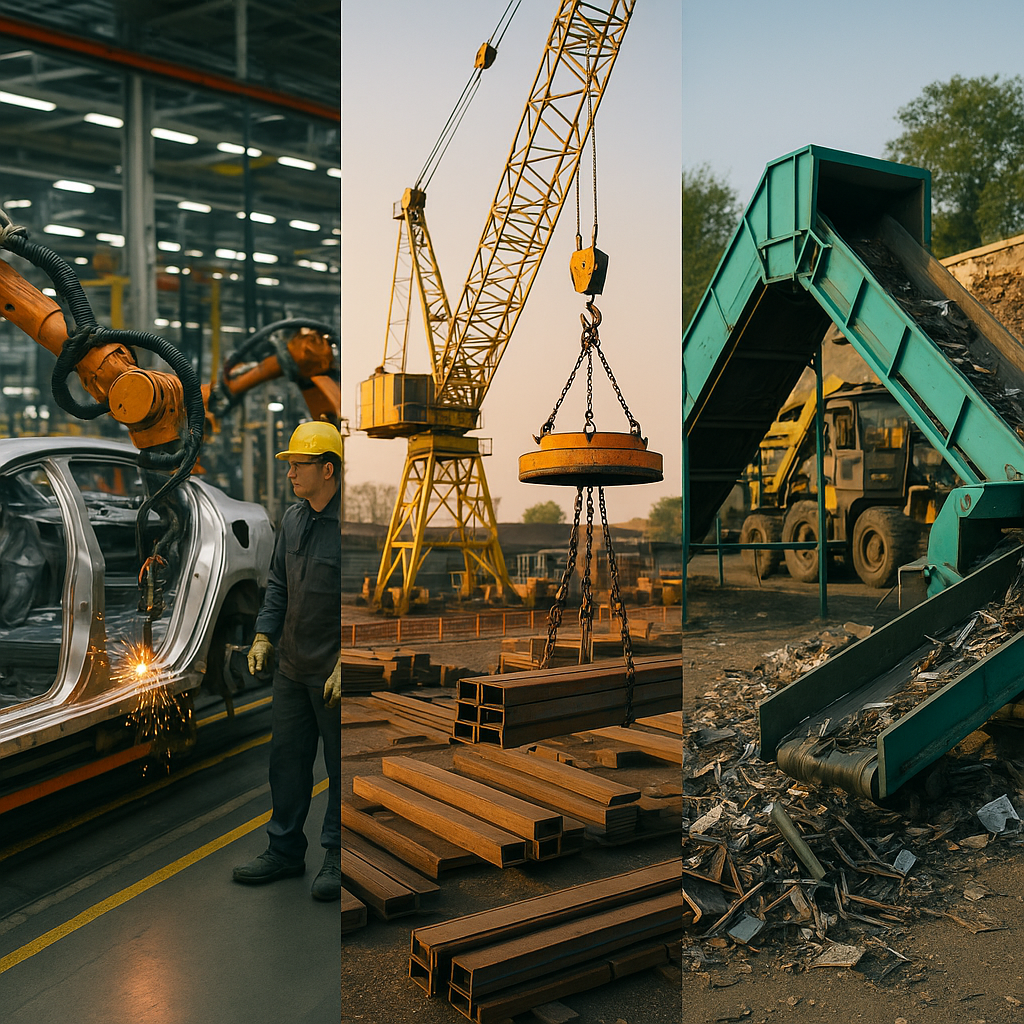5901 Botham Jean Blvd, Dallas, TX 75215
Scrap Iron Magnets: How Electromagnets Boost Recycling Efficiency, Safety, and Sustainability
September 2, 2025A scrap iron magnet is a specialized industrial tool designed for handling and sorting ferrous metals in recycling facilities and scrapyards. This powerful electromagnet generates a deep magnetic field capable of lifting substantial quantities of iron, steel, and other magnetic materials. Unlike permanent magnets, scrap iron magnets can be activated and deactivated with the flip of a switch, making them ideal for material handling operations.
The basic design consists of a durable iron core wrapped with numerous turns of insulated copper wire. When electricity flows through this coil, it generates a magnetic field strong enough to attract and hold ferrous metals. Operators control these magnets from their equipment cabs by pressing one button to engage the magnetic field and another to release the load at the desired location.
Scrap iron magnets are typically mounted on cranes, excavators, or other heavy equipment. Their lifting capacity varies widely, from several hundred pounds for smaller units to many tons for industrial-grade models. This flexibility makes them indispensable in modern recycling operations, where efficiently separating ferrous from non-ferrous materials directly impacts productivity and profitability.
How Do Scrap Iron Magnets Work?

Scrap iron magnets operate based on the principles of electromagnetism. These specialized industrial tools convert electrical energy into magnetic force. A copper wire coil is wound around a soft iron core, and when electricity flows through this coil, it generates a magnetic field that extends from the device.
These electromagnets specifically attract ferrous materials—those containing iron, like steel. This selective attraction makes them valuable in recycling operations. The magnetic field penetrates deeply into mixed material piles, effectively grabbing metal from beneath other debris.
A key advantage of scrap iron electromagnets is their controllability. Operators can adjust the magnetic field strength by regulating the electric current. More current produces a stronger magnetic field, allowing heavier loads to be lifted. This adaptability makes these tools suitable for various recycling tasks.
The operation is straightforward. When the operator activates the electromagnet, it creates a magnetic field that attracts and secures ferrous metals. Once the load is moved to the desired location, the operator turns off the current. The magnetic field disappears, and gravity takes over, dropping the materials precisely where needed.
Unlike permanent magnets, electromagnets offer complete control over when the magnetic force is active. This on-off capability provides significant advantages in recycling facilities. If a permanent magnet were used, substantial mechanical force would be required to remove the attracted metal. Electromagnets eliminate this problem.
Most scrap magnets include safety systems. If power is lost during operation, the magnetic field collapses immediately, dropping the load. While this prevents equipment damage, it poses potential hazards below. Modern systems often include backup power sources to prevent accidental drops.
The size of scrap electromagnets varies based on application requirements. Smaller units might lift several hundred pounds, while industrial-grade systems can hoist tons in a single lift. This versatility makes them adaptable to operations ranging from small-scale sorting to large industrial processing.
What Industries Use Scrap Iron Magnets?

Scrap iron magnets are essential in various industries where metal separation, recovery, and handling are required. Their efficiency in sorting and moving ferrous materials makes them indispensable in modern recycling and manufacturing.
Scrapyards and recycling facilities are the primary users of these powerful magnetic systems. Here, scrap magnets separate valuable ferrous metals from mixed waste streams, load and unload large quantities of processed scrap onto transport vehicles, and feed shredders and balers to ensure consistent material flow. The benefits include increased throughput, improved material purity, reduced manual labor, and enhanced worker safety.
The demolition and construction sectors rely heavily on scrap magnets for extracting metals from debris. On demolition sites, these magnets effectively lift rebar, structural steel, and other ferrous components directly from rubble, expediting site clearance and creating new revenue streams from recovered materials. At transfer stations, magnets separate metals from wood, concrete, and other construction waste, reducing the amount of material destined for landfills.
Foundries and steel mills use scrap magnets for precise material handling. These facilities rely on magnets to load furnaces with metal feedstock, organize various grades of scrap inventory, and recover valuable ferrous materials from slag heaps. This enhances operational efficiency and ensures the purity of input materials for metal production. The magnets handle everything from loose scrap to heavy, oddly shaped metal pieces with precision.
In the automotive recycling industry, scrap magnets extract ferrous components from end-of-life vehicles. These powerful tools are used in both pre-shredder applications, removing larger metal parts before processing, and post-shredder operations, where they separate shredded ferrous material from non-ferrous metals and other materials. This multi-stage magnetic separation is crucial for producing clean, high-grade ferrous scrap that commands premium prices in the recycling market.
The steel manufacturing sector greatly benefits from scrap magnets. Over 60 percent of raw steel in the United States is produced using recycled materials, with magnets playing a vital role in processing the 66 million metric tons of ferrous scrap handled annually in the U.S. alone. This contributes to nearly $18 billion in export sales generated by the recycling industry.
What Are the Benefits of Using Scrap Iron Magnets?

Scrap iron magnets enhance industrial recycling operations with multiple advantages. These specialized tools streamline material handling and add significant value across various sectors, including scrapyards and demolition sites.
Operational Efficiency and Throughput Increase
One of the primary benefits of scrap iron magnets is their ability to greatly boost operational efficiency. They facilitate the rapid handling of large amounts of ferrous materials, dramatically reducing processing times compared to manual sorting methods.
These powerful magnets streamline material flow by swiftly lifting, sorting, and moving substantial quantities of ferrous scrap in a single operation. This results in increased throughput, allowing facilities to handle more volume with the same resources.
In bustling scrapyards, electromagnets can process tons of metal per hour, maintaining a continuous workflow unmatched by traditional sorting methods. The quick transfer of materials from sorting areas to processing equipment eliminates bottlenecks and enhances overall productivity.
Enhanced Safety in Material Handling
Improved safety is another key advantage of using scrap iron magnets. By reducing the need for manual handling of potentially dangerous materials, these tools significantly reduce workplace injury risks.
Workers avoid direct contact with sharp edges, heavy objects, or hazardous substances present in scrap piles. Magnets enable operators to control the lifting and moving process from a safe distance, minimizing exposure to risks.
This reduction in manual handling not only protects workers but also lowers operational costs related to injuries, insurance, and compliance. The safety factor alone makes scrap iron magnets an essential investment for responsible recycling operations.
Improved Material Purity and Value
Scrap iron magnets significantly improve the purity of sorted materials through their selective attraction properties. They efficiently separate ferrous metals from non-ferrous materials, resulting in cleaner, higher-quality recycled scrap.
This enhanced sorting capability leads to financial gains. Purer ferrous scrap commands better market prices and meets stringent quality requirements of steel mills and foundries. Non-ferrous materials are also more effectively recovered and sorted for separate processing.
The sorting capability of these magnets improves material recovery rates, with some operations reporting up to 95% capture efficiency for ferrous materials. This precision creates new revenue streams by recovering valuable metals that might otherwise be lost.
Environmental Sustainability and Waste Reduction
From an environmental perspective, scrap iron magnets contribute significantly to sustainability efforts. By promoting more efficient metal recycling, they help conserve natural resources and reduce the need for virgin material extraction.
The effective separation of ferrous metals ensures more recyclable materials are kept out of landfills. This waste reduction helps facilities meet environmental compliance standards while supporting circular economy principles.
Recycling operations utilizing electromagnetic separation can process materials more thoroughly, capturing smaller metal pieces that manual sorting might miss. This comprehensive approach results in less waste and more complete resource recovery, supporting broader environmental goals across the industry.
Conclusion: The Impact of Scrap Iron Magnets on Industry
Scrap iron magnets are essential in modern recycling and metal processing operations. Their ability to efficiently sort and separate ferrous materials has revolutionized waste management across industries. These powerful tools enable recycling facilities to process tons of mixed metal waste daily with remarkable precision, creating value from what was once considered unusable material.
The environmental and economic benefits of scrap iron magnets are significant. By facilitating efficient metal recovery, these devices support the circular economy, reduce the need for virgin material extraction, and minimize energy consumption in manufacturing processes. The recycling industry’s contribution of over $105 billion in economic activity annually across the United States is partly due to these magnetic separation technologies.
For your industrial magnet recycling needs in your operations, contact Okon Recycling at 214-717-4083.
